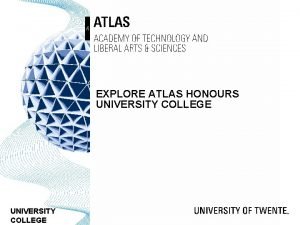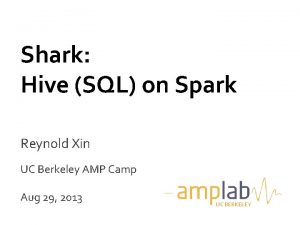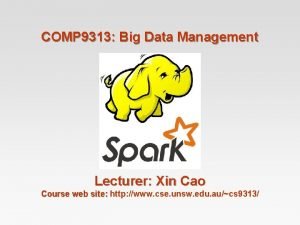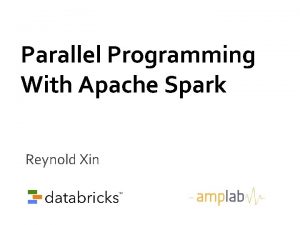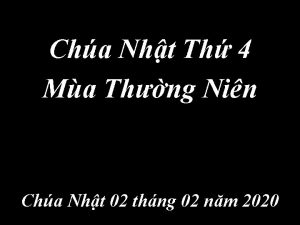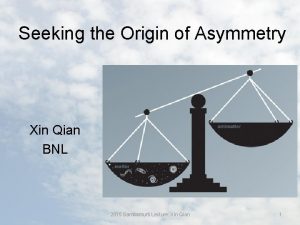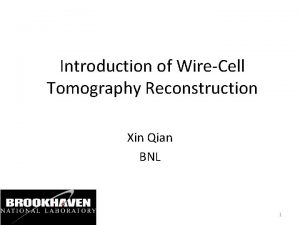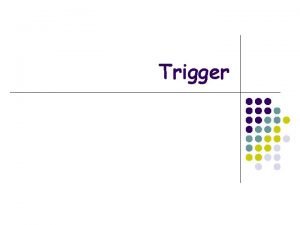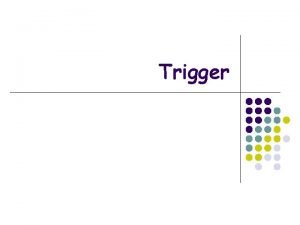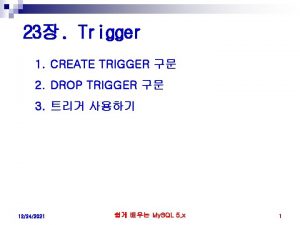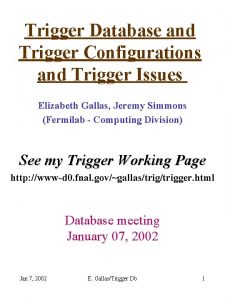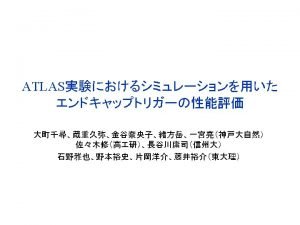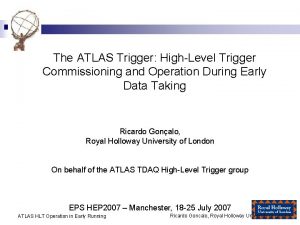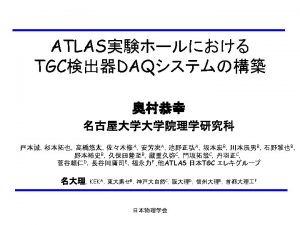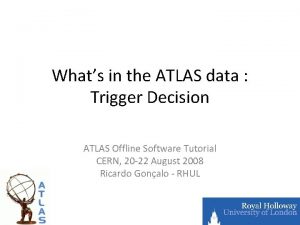ATLAS Egamma Trigger Overview Xin Wu University of


















- Slides: 18

ATLAS Egamma Trigger Overview Xin Wu University of Geneva X. Wu, March 2006 1

Outline § § § § Introduction LVL 1 EM Trigger LVL 2 EM Trigger EF EM Trigger Overall Performance Online Integration Conclusion X. Wu, March 2006 2

Introduction Ø Egamma Trigger: online selection of electrons and photons – LVL 1: hardware processors to reconstruct (isolated) EM cluster – LVL 2: Seeded fast Athena clustering and tracking algorithms – EF: (seeded) offline clustering and tracking algorithms Ø Responsible for a large fraction of data for ATLAS physics – Inclusive electron, dielectron (e 25 i, 2 e 15 i) • Main triggers for W, Z, dibosons, top, Higgs, SUSY, Exotics – Inclusive photon, diphoton ( 60 i, 2 20 i) • Main triggers for direct photon, H , Exotics – Exclusive (combination and topological) triggers Ø Dominant contributor to the trigger rate TDAQ TDR – ~65% of LVL 1 rate at L=2 E 33 • Total LVL 1: 25 KHz; EM 25 I: 12 k. Hz; 2 EM 15 I: 4 k. Hz – ~35% of EF rate at L=2 E 33 • Total EF: 200 Hz; e 25 i+2 e 15 i: 41 Hz; 60 i+2 20 i: 27 Hz X. Wu, March 2006 3

LVL 1 Calorimeter Trigger System Calorimeters (LAr, Tile) S 0. 1 x 0. 1 Ro. I identification e/ /t classification Threshold count analogue ~75 m Rx Cluster Processor Ro. I Builder Pre. Processor Timing alignment 10 -bit FADC FIR filter BCID LUT Sum 2 x 2 BC-MUX 400 Mb/s Jet/Energy Processor Sum Em+Had ET Ex, Ey Jet identification Threshold count SET, ET 0. 1 x 0. 1 0. 2 x 0. 2 X. Wu, March 2006 L 1 CTP DAQ 4

LVL 1 EM Ro. I Reconstruction Ø Ro. I EM Core: a 0. 2 x 0. 2 local EM Et maximum Ø EM Cluster: most energetic of the four Ro. I Core Trigger. Tower 0. 1 x 0. 1 2 -tower EM clusters in th Ro. I Cluster – Et : LVL 1 EM cluster Et Em Cluster Ø EM isolation – Total Et of the 12 EM towers around the Ro. I Cluster EM Isolation Ø Hadronic core isolation – Total Et of the 4 hadronic towers HAD core behind the Ro. I Core Isolation Ø Hadronic ring isolation – Total Et of the 12 hadronic towers around the Ro. I Core X. Wu, March 2006 HAD ring Isolation 5

LVL 1 Calorimeter Simulation Software Ø Analog tower sum simulation – Need to be run at digitization stage – LAr. L 1 Sim : make LAr. TTL 1 objects from hits (Fabienne Ledroit) – Tile. Hit. To. TTL 1 : make Tile. TTL 1 from hits Ø Trig. T 1 Calo : trigger tower digitization and Ro. I building – Use either TTL 1 or Cells as input – Can be run at digitization or reconstruction stage – Make Trigger. Tower, Em. Tau. ROI, Jet. ROI, Energy. Ro. I objects – Provide simulated input (Ro. I’s) to HLT • Starting point for all efficiency/rate numbers ! Ø CTPsim : make L 1 decisions for a given L 1 menu Ø EDM in ESD/AOD – Trigger. Towers – L 1 EMTau. Object. Container: collection of LVL 1 EM clusters – LVL 1_ROI: collection of LVL 1 Ro. Is ( , , threshold passed) X. Wu, March 2006 6

LVL 1 Egamma Performance Ø Benchmark numbers frequently updated with MC production and reconstruction releases – Eg. EM 25 i (M. Wielers) • Rome data: eff=96. 7%, rate 5. 6 k. Hz (L=1 E 33) • CSC validation: eff=96. 5%, rate 6. 0 k. Hz (L=1 E 33) Ø Detailed studies will be done with CSC data – Efficiency turn-on, noise effects, algorithm bias, dependence of isolation on event topology, … Ø Full characterization of LVL 1 with data has high priority at the beginning of data taking – Tower noise threshold: 250 Me. V steps – Isolation cut: HAD core, HAD ring, EM ring – Energy scale: 1 Ge. V or 500 Me. V or 250 Me. V – Efficiency turn-on – Clustering algorithm tuning, … X. Wu, March 2006 7

L 2 Egamma Calorimeter Algorithm 4 Processing steps of T 2 Calo. Egamma at each step data request is made and accept/reject decision is possible Rcore= E 3 x 7/E 7 X 7 in EM Sampling 2 Eratio=(E 1 -E 2)/(E 1+E 2) in EM Sampling 1 p 0 g Et. Em=Total EM Energy (add sampling 0 and 3) Et. Had=Hadronic Energy (Tile or HEC) X. Wu, March 2006 8

L 2 Egamma Cluster Reconstruction Ø Samp 2 Fex : in sampling 2 – – Find seed cell: hottest cell in the 0. 2 x 0. 2 window around LVL 1 Ro. I sum E in 3*7 and 7*7 cells windows around seed Rcore Cluster center = E weighted eta, phi in a 3 x 7 window around seed Cluster is a 3 x 7 window around the new cluster center Ø Samp 1 Fex: in sampling 1 (strips) – Update cluster energy – Find max E and second max E strips in a window of 0. 125 x 0. 196 around cluster center Eratio Ø Sam. En. Em. Fex – Update cluster energy with sampling 0 and 3 cells – Energy correction applied Et. Em Ø Sam. En. Had. Fex – Calculate sum E of HEC or Tile in 0. 1*0. 1 window around cluster center Et. Had X. Wu, March 2006 9

L 2 Egamma Calo. Data Preparation Ø Region. Selector – Return list of cells and ROB’s in the Ro. I window • Initialization from LAr/Tile Geometry (F. Ledroit) Ø Retrieve ROB data – 2 GB/s link ROS LVL 2 Ø Byte. Stream data conversion (the main bottle beck) – Coupled tightly to ROD data format, DSP processing • Continuous optimization (B. Laforge, D. Fournier, …) – Dedicated LVL 2 Byte. Stream conversion (D. Damazio) • Cell memory allocated and geometry initialized during initialization • Organize cells in TT (Trigger Tower) • Modified decoding method – Factor of 6 faster than offline BS conversion Ø Not yet investigated – Handle dead/noise cells and timing information – Performance study with respect to zero suppression X. Wu, March 2006 10

L 2 Egamma Calo. Timing Performance D. Damazio Offline Conversion Fast Conversion Ø Fast conversion will become default for release 12 and 11. 0. 6 – Validation with physics performance Ø Further improvements – exploit the new ROD data format (B. Laforge) • fixed length block structure, hot cell index, . . . – use of faster/smaller LAr. Cell (D. Damazio) Ø A LVL 2 Egamma Calo. code review is being planned for May-July X. Wu, March 2006 11

LVL 2 Tracking Algorithms Ø Seeded with LVL 2 calo clusters – Search window 0. 2 x 0. 2 (could be narrowed by better Z position from T 2 Calo using strips) Ø 2 independent tacking algorithms with Pixel and SCT – IDScan: histogram method for pattern recognition; Kalman filter for track fitting • Total execution time ~4. 1 ms (Data. Prep ~3. 5 ms) – Si. Track: LUT method for finding triplet track segments straight line (R/Z) and circle (R/Phi) track fitting Ø Tool for track extension to TRT: Trig. TRT_Track. Extension. Tool – Use Probabilistic Data Association Filter • ~ 1 ms/track + Data. Prep Ø TRT standalone and full Inner Detector tracking – TRTx. K: wrapper for the offline tool Xkalman • Total TRT execution time ~4. 6 ms (Data. Prep ~2 ms) X. Wu, March 2006 12

EF Egamma Calorimeter Reconstruction Ø Wrap offline tools to EF environment (Cibran Santamarina) – Seeded approach, interface to trigger steering Trig. Calo. Rec X. Wu, March 2006 13

EF Egamma Tracking Reconstruction Ø Wrap offline new. Tracking tools (I. Grabowska-Bold) – All EF ID algorithms available since release 11. 0. 0 Ø The full Egamma slice is running on BS input with 11. 0. 5 nightlies X. Wu, March 2006 14

Overall Egamma Performance Ø Many studies and optimizations have been done with Rome data and are being repeated for CSC data – Eg. e 25 i for 1 E 33 from M. Wielers, crack region excluded Step LVL 1+LVL 2+EF+offline LVL 1+offline CSC validation data X. Wu, March 2006 Eff (%) 96. 7 80. 3 73. 5 76. 1 Rate 5. 6 k. Hz 42 Hz 34 Hz 73 Hz Rome data Offline = is. EM = 78% Step LVL 1 offline LVL 1+LVL 2+offline LVL 1+LVL 2+EF+offline LVL 1+EF LVL 1+LVL 2+EF Eff (%) 96. 5 83. 9 81. 8 80. 7 79. 2 81. 7 80. 7 Rate 6 k. Hz 180 Hz 78 Hz 52 Hz 33 Hz 59 Hz 40 15 Hz

Comment on Overall Performance Ø Performance numbers are only indicative due the fast evolution of software (trigger and offline) Ø Studies need to couple tightly with offline Egamma reconstruction (not always easy!) Ø Equally important and more challenging is to understand all individual variables – Geometrical, physical and topological bias – robustness against noise – efficiency calculation with data – Simplicity from the point of view of MC simulation, offline reconstruction and real data verification – correction and calibration Ø The final optimization can only be done with data – Get tools ready X. Wu, March 2006 16

HLT integration: Online vs. Online Simulaton vs. Offline GAUDI with support for multiple threads Online GAUDI Online Sim DAQ Data Flow ATHENA Environment L 2 PU/EFPT athena. MT/PT Steering Controller Algorithms ROS X. Wu, March 2006 Byte. Stream File (RDO) Offline ATHENA Environment Algorithms Byte. Stream File or Pool(RIO) File 17

Conclusions Ø Full HLT Egamma slice has been implemented – Basic functionalities and performance satisfactory – Great progresses have been made on more technical areas • LVL 2 data preparation, EDM, EF wrappers, athena. MT, … Ø Next – Validation and performance studies with CSC samples – Integration on HLT pre-series with 11. 0. 6 – Correction and calibration schemes; Monitoring – Algorithm reviews and improvements – Trigger menu for L=1 E 31 • Benchmark physics channels (W, Z, top, DY, Diboson, direct , searches, …) – “Trigger-aware” analyses (physics groups) • Startup scenario for Egamma slice • Trigger/data sample/physics channel for Egamma verification, optimization and efficiency calculation – Tools for trigger commissioning with data X. Wu, March 2006 18
 Atlas university college
Atlas university college Sqlshark
Sqlshark Con xin dâng lên muôn lời suy tôn
Con xin dâng lên muôn lời suy tôn Tinthac.net
Tinthac.net Lạy cha xin tha cho họ
Lạy cha xin tha cho họ Một người ăn xin đã già
Một người ăn xin đã già Comp9313
Comp9313 Lady dai xin zhui
Lady dai xin zhui Xin cho lòng chúng con luôn
Xin cho lòng chúng con luôn Lạy chúa chí ái tiếng con nài xin
Lạy chúa chí ái tiếng con nài xin Linh hồn tôi ơi hãy ngợi khen thiên chúa
Linh hồn tôi ơi hãy ngợi khen thiên chúa Reynold xin
Reynold xin Maranatha, lời nguyện thiết tha
Maranatha, lời nguyện thiết tha đông qua mau trúc xinh nghiêng nghiêng đợi chờ
đông qua mau trúc xinh nghiêng nghiêng đợi chờ Lạy chúa chí tôn xin dủ tình xót thương con
Lạy chúa chí tôn xin dủ tình xót thương con Xin giữ con để con phụng sự chúa
Xin giữ con để con phụng sự chúa Xin qian bnl
Xin qian bnl Xin than linh den
Xin than linh den Xin qian bnl
Xin qian bnl
